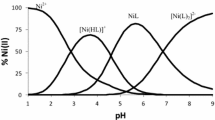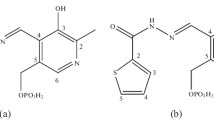Abstract.
The acidity constants of twofold protonated methyl thiophosphate (MeOPS2–) and of monoprotonated uridine 5'-O-thiomonophosphate (UMPS2–) have been determined in aqueous solution (25 °C; I = 0.1 M, NaNO3) by potentiometric pH titration. The stability constants of their 1:1 complexes formed with Pb2+, i.e. Pb(MeOPS) and Pb(UMPS), have also been measured. The results show that replacement of a phosphate oxygen by a sulfur atom increases the acidity by about 1.4 pK units. On the basis of recently established log \(K_{{\rm Pb(R \hbox { - } PO}_{\rm 3} )}^{{\rm Pb}}\) versus \({\rm p}K_{{\rm H(R} \hbox { - } {\rm PO}_{\rm 3} )}^{\rm H} \) plots (\({\rm R \hbox { - } PO}_{\rm 3}^{{\rm 2} - }\) = simple phosphate or phosphonate ligands where R is a non-coordinating residue), it is shown that the stability of the Pb(thiophosphate) complexes is by log Δ= 2.43±0.09 larger than expected for a Pb2+-phosphate interaction. The identity of the stability increase (log Δ) observed for Pb(MeOPS) and Pb(UMPS) shows that the nucleobase residue in the Pb(UMPS) complex has no influence on complex formation. To be able to carry out the mentioned comparisons, we have also determined the stability constant of the complex formed between Pb2+ and methyl phosphate; the corresponding data for Pb(UMP) were already known from our earlier studies. The present results allow an evaluation of other Pb2+ complexes formed with thiophosphate derivatives and they are applied now to the Pb2+ complexes of adenosine 5'-O-thiomonophosphate (AMPS2–). The stability constants of the Pb(H;AMPS)+ and Pb(AMPS) complexes were measured and it is shown that, within the error limits, the stability of the Pb(AMPS) complex is determined by the basicity of the thiophosphate group of AMPS2–; in other words, no hint for macrochelate formation involving N7 was observed. More important, with the aid of micro-stability-constant considerations it is concluded that the structure of the dominating isomer of the Pb(H;AMPS)+ species is the one where the proton is located at the N1 site of the adenine residue and Pb2+ is coordinated to the deprotonated thiophosphate group. The insights gained from this study with regard to thiophosphate-altered single-stranded nucleic acids and their affinity towards Pb2+ are discussed.
Similar content being viewed by others
Author information
Authors and Affiliations
Additional information
Electronic Publication
Rights and permissions
About this article
Cite this article
Da Costa, C.P., Krajewska, D., Okruszek, A. et al. Stabilities of lead(II) complexes formed in aqueous solution with methyl thiophosphate (MeOPS2–), uridine 5'-O-thiomonophosphate (UMPS2–) or adenosine 5'-O-thiomonophosphate (AMPS2–). J Biol Inorg Chem 7, 405–415 (2002). https://doi.org/10.1007/s00775-001-0316-0
Received:
Accepted:
Published:
Issue Date:
DOI: https://doi.org/10.1007/s00775-001-0316-0




